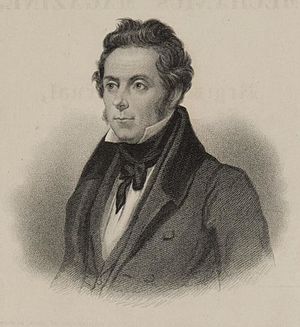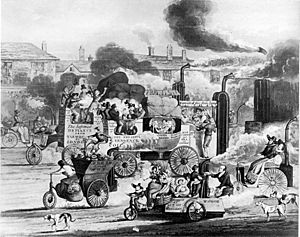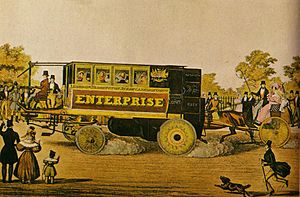Walter Hancock facts for kids
Quick facts for kids
Walter Hancock
|
|
|---|---|
 |
|
| Born | 16 June 1799 Marlborough, England
|
| Died | 14 May 1852 (aged 52) |
| Nationality | English |
| Occupation | Engineer |
| Engineering career | |
| Projects | Steam-powered road vehicles |
Walter Hancock (born June 16, 1799 – died May 14, 1852) was an amazing English inventor. He lived during the Victorian period, a time of great change. Walter Hancock is best known for creating vehicles that ran on steam. He also got a special patent for how to prepare and cut natural rubber into sheets. His older brother was Thomas Hancock, who invented a way to process rubber. Some people even say Thomas invented rubber vulcanization, which makes rubber stronger.
Contents
Walter Hancock's Steam Buses
Between 1824 and 1836, Walter Hancock built several steam-powered vehicles. He worked in Stratford, which is near London. In 1827, he received a patent for a special steam boiler. This boiler was made with thin metal chambers. If it broke, it would split open instead of exploding. This was a very important safety feature for both drivers and passengers.
Hancock's vehicles were not the very first steam-powered road machines. Richard Trevithick had experimented with his "Puffing Devil" and "London Steam Carriage" much earlier. However, Hancock's steam vehicles were the most successful ones of their time. It's interesting to note that railways were also starting to appear in England around the same time.
In 1831, Hancock even shared his ideas with a special group in the British Parliament. They were looking into steam carriages.
The "Infant" Steam Bus
In 1829, Hancock built a small bus called the Infant. It could carry 10 passengers. In 1831, he started a regular bus service with the Infant. This service ran between Stratford and central London.
On October 31, 1832, the Infant made a special test trip to Brighton. This journey became famous because it was the first time a steam vehicle earned money carrying passengers between London and Brighton. The Infant also showed how useful it was by successfully climbing a frozen hill. Horse-drawn coaches were struggling on the same slope, but the Infant made it!
The "Enterprise" Steam Bus
On April 22, 1833, Hancock's steam bus called Enterprise began a regular service. This bus was built for the London and Paddington Steam Carriage Company. It traveled between London Wall and Paddington, going through Islington. This was the first regular steam carriage service ever. It was also the first vehicle designed especially to be a public bus that ran on its own power.
During the building of the Enterprise in 1832, there was an incident. A part of the boiler tore, and high-pressure steam escaped. Luckily, no one was physically hurt. This showed how important Hancock's safe boiler design was.
The Enterprise had many cool new features for its time.
- The engine was held up by springs, just like the body of the bus.
- The wheels were connected with swinging arms, similar to how some pickup trucks work today.
- Power went to the wheels using a chain drive.
- The back axle also powered a fan. This fan blew air into the firebox to keep the fire burning strong.
The Enterprise needed three people to operate it normally:
- The driver sat at the front. They steered the bus with a steering wheel (not a simple lever). They also controlled the speed.
- A second person sat in a small area at the back. This person made sure the boiler had enough water. They also chose reverse gear when needed.
- The third person stood on a platform at the very back. They kept the fire going and used a large lever to brake one of the back wheels. We don't know how these three people talked to each other!
This bus service eventually stopped because of a disagreement between Hancock and the company running it. However, Hancock continued to build and operate more steam buses himself. Between 1833 and 1840, he made buses with names like Era I, Era II, Autopsy, and German drag.
The "Automaton" Steam Bus
In 1836, Hancock introduced the Automaton. This bus could carry 22 passengers. It completed over 700 journeys! It traveled between London and Paddington, London and Islington, and Moorgate and Stratford. In total, it carried more than 12,000 passengers. The Automaton regularly traveled at 12 to 15 miles per hour. It could even reach a top speed of over 20 miles per hour!
Why Steam Buses Disappeared
By 1840, the idea of steam-powered road vehicles started to fade away. One big reason was the very high road tolls. These were special fees charged to use roads, set by laws called Turnpike Acts. These high costs made inventors turn away from steam power for roads. Instead, they focused on steam power for railways.
Walter Hancock had to stop his fight to keep steam buses going. This left the way open for buses pulled by horses to take over.
Even though his road vehicles didn't last, Hancock kept working with steam. He even provided a light engine, similar to his steam road coaches, to the Eastern Counties Railway.
Walter Hancock's Travel Statistics
Walter Hancock kept careful records of his steam bus journeys. Here are some interesting facts:
- His buses traveled a total distance of 4,200 miles.
- They carried 12,761 passengers.
- He made 143 round trips from the city to Paddington.
- He made 525 trips from the city to Islington.
- He made 44 trips to Stratford.
- His buses used about 165 tons of coke fuel. This meant they could travel about 76 miles per ton of coke.
- The fuel cost about 2 pence per mile.
- On average, each vehicle was in service for 5 hours and 17 minutes each day.
- A round trip of 9 miles from Moorgate to Paddington took about 1 hour and 10 minutes.
See also




